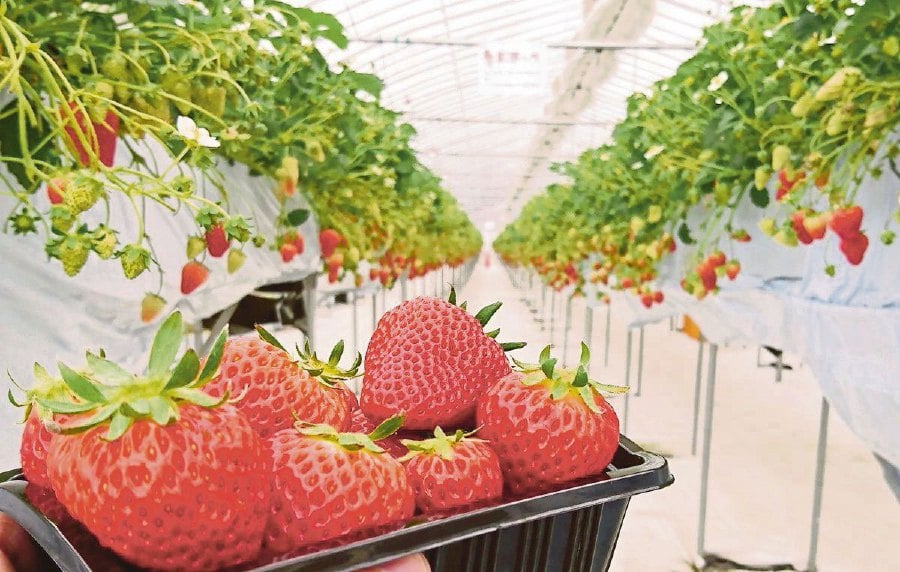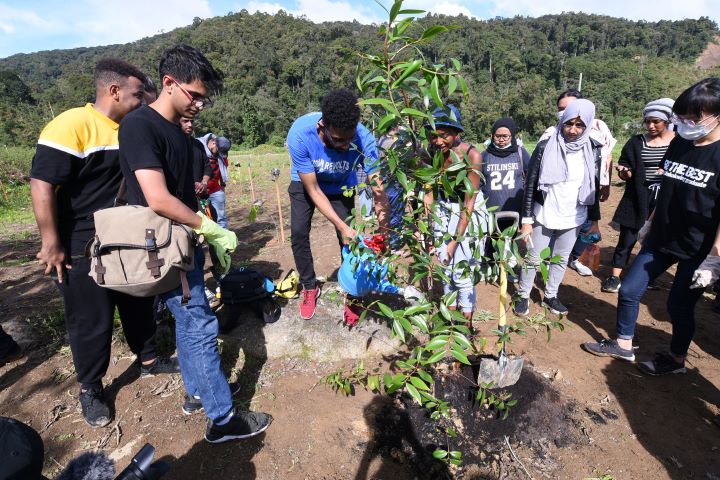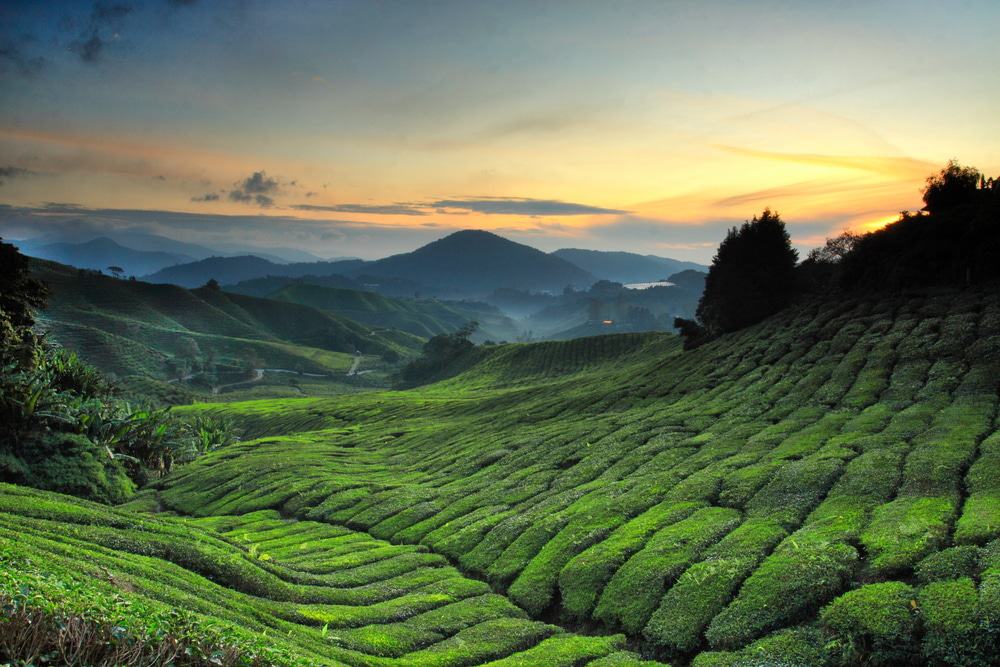Cameron Highlands in Pahang was once a tourist hotspot in decades past. But climate change threatens to end its position as a prime tourist destination.
Let’s take a trip down memory lane and look at the history of Cameron Highlands, how it became one of the prime vacation spots in the country and how a warming world is changing it for the worse.
Birth Of A Resort
Cameron Highlands was discovered in 1885 by English surveyor William Cameron, who also lent the region his name and his companion Kulop Riau, under a commission by the colonial government to map out the Titiwangsa Range[1]. Forging a path through dense vegetation, he reached a magnificent and sublime plateau “shut up in the mountains” along the vast Titiwangsa Range[2].

But it wasn’t until Sir George Maxwell visited the region in 1925 that its development as a hill resort began. There, Sir Maxwell decided to develop the present Tanah Rata and Brinchang areas into a Hill Station (a town located at a higher elevation than the nearby plain or valley)[1]. From there, the region soon became a haven for the British stationed in Malaysia, looking for relief from the hot and humid tropical climate. Many of them had also decided to make Cameron Highlands their retirement home, setting up bungalows and mansions[1].
British planters had also discovered that the climate and fertile soils of the mountain slopes were suitable for growing tea. It was here that John Archibald Russell established the famous BOH tea plantation in 1929. Cameron Highlands still remains the largest tea-producing region in Malaysia, as well as being a major supplier of vegetables and legumes for both Malaysia and Singapore[1]. It is also the centre of strawberry production in Malaysia – with strawberry farms making up an iconic part of the region’s landscape[3].
Cameron Highlands is also a popular tourist destination, supporting a population of close to 50,000 people spread over eight interconnecting areas[2]. Tourists, both local and foreign, have visited the region to tour the plantations, admire the Tudor-style buildings and experience the cool cloud forest environment.
But lately, the resort has been threatened by a number of factors.
Thinning Forests

According to Global Forest Watch, Cameron Highlands, in 2010, had 64.0kha of tree cover, extending over 90% of its land area. In 2021, it lost 62.6ha of tree cover, equivalent to 33.0kt of CO₂ emissions[4].
Over the past decades, Cameron Highlands has been subjected to uneven development, with large tracts of its cloud forests being cut down to make way for infrastructure, housing or agricultural developments, most of the time illegally. As a result of this illegal deforestation, large stretches of mountain slopes are now bald, with their soils exposed to the elements[5].
The greed and corruption driving this deforestation led to tragedy in 2014 when mudslides and landslides struck Kampung Raja, Ringlet Town and Bertam Valley on November 5th 2014, resulting in 5 deaths and the displacement of numerous families from their homes[6].
In September this year, another landslide caused by illegal deforestation occurred near Kampung Raja, leaving the residents worried and uneasy[7].
The Threat Of Warming Temperatures
The over-development of Cameron Highlands, together with ongoing climate change, has led to the region losing its characteristically cool climate, with minimum temperatures increasing by 7.5°C over the past three decades[8], much to the detriment of both the residents and visitors.
In the summer of this year, the Meteorological Department recorded temperatures between 16°C and 23°C, far higher than what people expected[8].
Forests help regulate the temperature. However uncontrolled land clearing would lead to soaring temperatures, not to mention other environmental damage, such as floods and landslides, which are already happening. – Roy Margaret, Regional Environmental Awareness Cameron Highlands (REACH) committee member[8]
Visitors coming to the highlands to escape the heat found that the heat had followed them to their dismay, prompting them to switch out their sweaters and jackets for short-sleeved shirts and shorts. Many resorts have even started installing air conditioners in their rooms in order to combat the uncharacteristic heat[8].
Tour guide Angela Marine Hoon, 65, said that people had never needed fans or any other cooling system during her 38 years of experience[8].
It used to be so cold here that going to Cameron Highlands was like visiting any cold European country. Nowadays, some visitors even ask if the hotel has fans installed in the rooms. – Angela Marina Hoon, a tour guide[8]
The rising heat also spells trouble for many of the crops growing in the highlands, especially the famed strawberries.
People have noted that strawberries from Cameron Highlands are smaller and sour, compared with the imported ones. – K. Kaliyannan, a tour guide[8]

Strawberries thrive in temperate climates, and the cool mountain slopes of Cameron Highlands provided such an environment conducive to growing big and sweet strawberries. But with temperatures rising above 23°C, the yields of the region’s most famous fruit are being negatively impacted[8].
With strawberry yields declining, many sellers have even resorted to buying imported strawberries and stingless bee honey from elsewhere before reselling it in Cameron Highlands[8].
We can see many vehicles even on weekdays, and traffic congestion in some parts of Cameron Highlands is now very common. Can you imagine how much greenhouse gases that come from running engines? – Angela Marina Hoon, a tour guide[8]
The Future?
Even with these clear problems, the development of Cameron Highlands still continues.
There were also plans for a theme park which were met with much backlash, and Malaysians expressed their anger towards these plans in an online petition[9].

“In recent years, there has been a lot of deforestation happening throughout Cameron Highlands, which caused massive land clearing, landslides, rising temperatures, and loss of natural habitat for animals and plant species.”
“Cameron Highlands is a unique place with its natural flora and fauna. It is unlike any other constituency in Malaysia; it is not only home to hundreds of floral species that are rare to the tropics, but it is also an area with a substantially different ecosystem,” said the copy on the petition’s page[9].
We can foresee extensive damage to nature if the proposed theme park in Habu is given the green light, not to mention the volume of visitors and vehicles going up once the park opens.
In addressing the increasing traffic in Cameron Highlands, the authorities should introduce a park-at-hotel policy and provide feeder buses that will take visitors to tourist spots. It will also help reduce vehicle emissions. – Dilip Martin, Regional Environmental Awareness Cameron Highlands (REACH) president[10]
Regional Environmental Awareness Cameron Highlands (REACH) president Dilip Martin had also expressed worries about these developments, stating that they should be halted while an environmental damage assessment is being carried out[11].
We welcome development, but all stakeholders, especially developers, should carry out due diligence, to ensure sustainability. Nature is what draws tourists here, not modern development. – Dilip Martin, Regional Environmental Awareness Cameron Highlands (REACH) president[11]
It’s not all bad news, however.
After seizing illegal farmland, the Pahang state government had been making concentrated efforts to convert these farmlands into permanent forest reserves. One of these efforts was the “Go Green With SASET” program in 2020, organised by the Sultan Ahmad Shah Environment Trust (SASET) in collaboration with the Pahang State Forestry Department (JPNP) and the Malaysia-Pahang Youth Council and attended by 300 volunteers[12].
The program was aimed at reforesting the land with full support from government bodies and the local community to provide educational opportunities to explore illegal deforestation and environmental concerns[12].

(Credit: SASET)/Source: The Rakyat Post
On February 15th 2020, less than 2 months after reclaiming the land from illegal farms, volunteers planted 1,500 forest trees at the Sungai Ichat Permanent Reserved Forests (PRFs)[12].
Although Cameron Highlands may not be the same place as you once remembered, there are still those who are fighting to protect this natural treasure from the threat of over-development.
We need to strike a balance between development in agriculture and preserving nature. What is tourism without the flora and fauna that Cameron Highlands is known for? – K. Kaliyannan, a tour guide[8]
Explore our sources:
- Sherlin. (2015). History of Cameron Highlands. Corn at Cameron. Link.
- Cameron Highlands. Link.
- Strawberry Farms. Link.
- Global Forest Watch. Link.
- R. Ramasamy. (2012). The ongoing destruction of Cameron Highlands. Malaysiakini. Link.
- Bernama. (2014). Cameron Highlands tragedy caused by greed, illegal land clearing. The Sun Daily. Link.
- F. Fong. (2022). Fresh Landslides In Cameron Highlands Raise The Alarm. The Rakyat Post. Link.
- N. Daim. (2022). Cameron Highland folk warn of lower strawberry harvests as temperatures rise. New Straits Times. Link.
- D.J. Wong. (2021). Over 18,000 Malaysians furious at plans to build theme park in Cameron Highlands. Mashable. Link.
- N. Daim (2022) ‘To save Camerons, halt projects’. New Straits Times. Link.
- N. Daim. (2022) Stop Cameron Highlands development while study is carried out, says green group. New Straits Times. Link.
- A. Dorall. (2020) Illegal Farms in Cameron Highlands Are Being Turned Into Forest Reserves. The Rakyat Post. Link.


